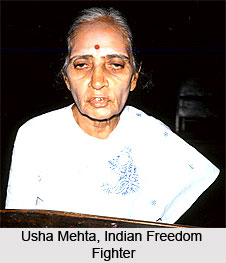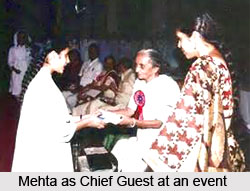 Usha Mehta was a woman freedom fighter of the country who was a great supporter of Mahatma Gandhi, and is respected for arranging an underground radio station known as the `Congress Radio`. The Congress Radio was also referred to as the `Secret Congress Radio` which operated during the period of the Quit India Movement, 1942. Usha Mehta had been awarded the Padma Vibhushan award by the Government of India in the year 1998, which is considered to be the greatest civilian award of the Indian Republic.
Usha Mehta was a woman freedom fighter of the country who was a great supporter of Mahatma Gandhi, and is respected for arranging an underground radio station known as the `Congress Radio`. The Congress Radio was also referred to as the `Secret Congress Radio` which operated during the period of the Quit India Movement, 1942. Usha Mehta had been awarded the Padma Vibhushan award by the Government of India in the year 1998, which is considered to be the greatest civilian award of the Indian Republic.
Early Life of Usha Mehta
Usha Mehta was born on 25th March, 1920 in the village of Saras close to Surat in the western Indian state of Gujarat and came across Mahatma Gandhi at a tender age of five during her visit to his ashram at the region of Ahmedabad. Soon afterwards, a camp was organised by Gandhiji near her village wherein she took part and displayed active interest, by attending his sessions and spinning. Her very first words of revolt against the British Raj in the country were `Simon Go Back` during a protest march aimed against the Simon Commission in 1928 when she was eight years old. Along with other children, Usha participated in such protest marches and picketed near the liquor shops. In one of these events, the children were chased by policemen and a young girl carrying the national flag tripped and fell down. The children were furious and narrated the incident to their parents who helped children to dress up in the colours of the Indian national flag and sent them into the streets some days later. Clad in these patriotic outfits, the children marched shouting, "Policemen, you can wield your sticks and your batons, but you cannot bring down our flag."
However, Usha Mehta was not permitted to get involved in the freedom movement by her father who worked as a judge under the British Raj. The restriction was lifted after her father retired in 1930. When she was 12, Usha moved to Mumbai with her family in 1932. She conveyed letters to her relatives who were imprisoned by the British, besides distributing publications and bulletins. She was highly inspired by Gandhi and decided to embrace the `spartan` way of life, wearing simple `Khadi` costumes and sacrificing all sorts of luxuries and material comforts. With the passage of time, Usha Mehta became a famous exponent of Gandhian thoughts and principles. Initially, she studied in schools in Bharuch and Khedar and eventually received education from Chandaramji High School, Mumbai. She passed her matriculation exams in the year 1935 and was amongst the top 25 students who secured the highest grades in her class. She pursued Philosophy and graduated from Wilson College, Mumbai during 1939. She had also started studying Law though she stopped her studied in 1942 in order to join the Quit India Movement. Therefore at the age of 22, she renounced her academics to lend her services to the Indian freedom struggle.
 Usha Mehta`s Role in Freedom Movement
Usha Mehta`s Role in Freedom Movement
The Congress and Mahatma Gandhi had proclaimed that The Quit India Movement would be started on 9th August, 1942 accompanied by a rally at Gowalia Tank in Mumbai. On the scheduled day innumerable visitors assembled at Gowalia Tank Ground, and since Gandhi had been arrested prior to that day Usha Mehta hoisted the national flag at the Gowalia Tank Ground which is also known as `August Kranti Maidan`. On 14th August, 1942 Usha Mehta and a few of her close confidantes began employing the concealed Congress Radio and her very first words in the radio broadcast included "This is the Congress radio calling on [a wavelength of] 42.34 meters from somewhere in India." Chandrakant Jhaveri, Nanka Motwani, owner of Chicago Radio, Babubhai Thakkar and Vithalbhai Jhaveri were some of her close associates. The Secret Congress Radio was supported by leaders like Purushottam Trikamdas, Achyutrao Patwardhan and Dr. Ram Manohar Lohia. Eventually, the secret radio was discovered by the police who arrested its directors and organisers which included Usha Mehta on 12th November, 1942.
She was constantly interrogated for six months by Criminal Investigation Department (CID), a department of Indian Police. She was then confined in solitary cells and was offered a chance to study overseas if she withdrew from the Quit India Movement. She refrained from making comments when she was questioned repeatedly by the Judge of the High Court. The trial sentences Usha Mehta to four years of imprisonment, from 1942 till 1946 and two of her comrades were also charged with involvement against the British Government. She was sent to Pune`s Yeravda Jail. Gradually her health declined and was sent to Sir J.J. Hospital for medical treatment in Mumbai. Some policemen kept a vigil over her so that she would be unable to escape. She was moved to Yeravda Jail when she recovered and she was finally set free in March 1946 following the orders of Morarji Desai, the then home minister, interim government.
Usha Mehta`s Role Post-Independence
Usha Mehta was incapable of taking active part in Indian politics on account of her steadily decaying health and she was compelled to stay in bed the day attained independence. So she could not be present at the event in Delhi. Later, she again started her education and composed a doctoral dissertation in the field of the social idealisms and political thoughts of Mahatma Gandhi which helped her receive a Ph.D from the University of Bombay. She was associated with this educational institute as a student, lecturer, professor, research assistant and then as the head of the department, Civics and Politics. In 1980, she retired from the University of Bombay.
Usha Mehta led an active social life following the Indian independence from the British Raj and continued propagating Gandhian philosophies. She wrote several books, essays and articles in Gujarati and English and was elected as the President of Gandhi Smarak Nidhi trust. She was also the member of the Gandhi Peace Foundation, New Delhi. She was associated with many celebrations held to commemorate India`s 50th anniversary of freedom by the Government of India.



















